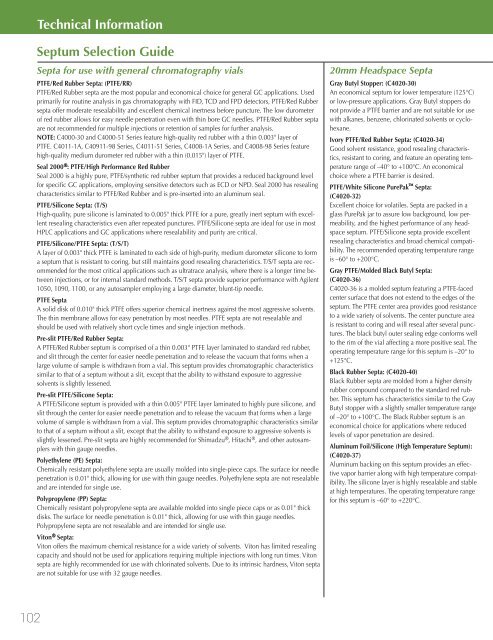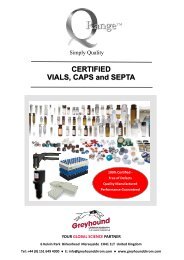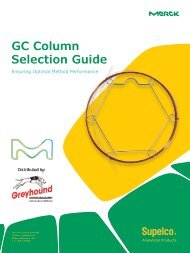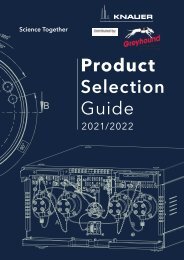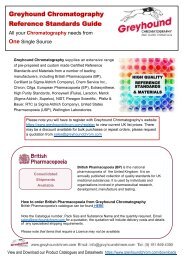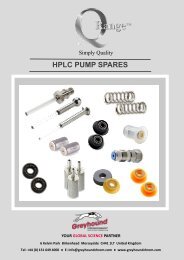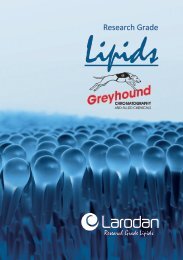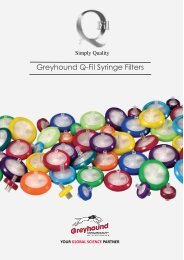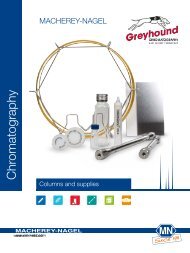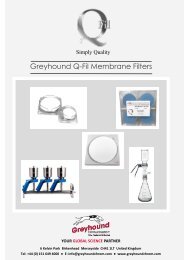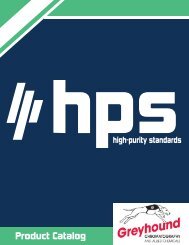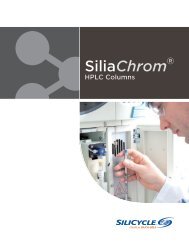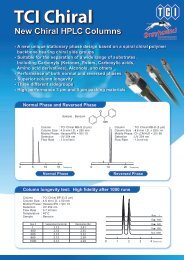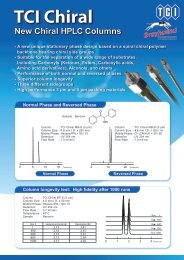National Scientific 2008-9 Catalogue
This catalogue contains product details of products from National Scientific. If you have any questions about National Scientific products or wish to discuss the pricing and delivery of products from this manufacturer, or any of the many other Manufacturers we represent, please do not hesitate to contact us either by email Sales@greyhoundchrom.com or rachel@greyhoundchrom.com (Greyhound Chromatography’s Sales Manager). We are proud of our long-standing relationships with our customers and agents. We value our agent network highly and are constantly looking to appoint new agents with the right expertise, in areas where we are not represented. Please email sales@greyhoundchrom.com if you are interested in becoming one of our agents. Visit https://www.greyhoundchrom.com for a full range of Chromatography consumables, including Certified Reference Standards and Materials, Solvents, Reagents and Laboratory Chemicals.
This catalogue contains product details of products from National Scientific. If you have any questions about National Scientific products or wish to discuss the pricing and delivery of products from this manufacturer, or any of the many other Manufacturers we represent, please do not hesitate to contact us either by email Sales@greyhoundchrom.com or rachel@greyhoundchrom.com (Greyhound Chromatography’s Sales Manager).
We are proud of our long-standing relationships with our customers and agents. We value our agent network highly and are constantly looking to appoint new agents with the right expertise, in areas where we are not represented. Please email sales@greyhoundchrom.com if you are interested in becoming one of our agents.
Visit https://www.greyhoundchrom.com for a full range of Chromatography consumables, including Certified Reference Standards and Materials, Solvents, Reagents and Laboratory Chemicals.
Create successful ePaper yourself
Turn your PDF publications into a flip-book with our unique Google optimized e-Paper software.
Technical Information<br />
Septum Selection Guide<br />
Septa for use with general chromatography vials<br />
PTFE/Red Rubber Septa: (PTFE/RR)<br />
PTFE/Red Rubber septa are the most popular and economical choice for general GC applications. Used<br />
primarily for routine analysis in gas chromatography with FID, TCD and FPD detectors, PTFE/Red Rubber<br />
septa offer moderate resealability and excellent chemical inertness before puncture. The low durometer<br />
of red rubber allows for easy needle penetration even with thin bore GC needles. PTFE/Red Rubber septa<br />
are not recommended for multiple injections or retention of samples for further analysis.<br />
NOTE: C4000-30 and C4000-51 Series feature high-quality red rubber with a thin 0.003" layer of<br />
PTFE. C4011-1A, C40911-98 Series, C4011-51 Series, C4008-1A Series, and C4008-98 Series feature<br />
high-quality medium durometer red rubber with a thin (0.015") layer of PTFE.<br />
Seal 2000e: PTFE/High Performance Red Rubber<br />
Seal 2000 is a highly pure, PTFE/synthetic red rubber septum that provides a reduced background level<br />
for specific GC applications, employing sensitive detectors such as ECD or NPD. Seal 2000 has resealing<br />
characteristics similar to PTFE/Red Rubber and is pre-inserted into an aluminum seal.<br />
PTFE/Silicone Septa: (T/S)<br />
High-quality, pure silicone is laminated to 0.005" thick PTFE for a pure, greatly inert septum with excellent<br />
resealing characteristics even after repeated punctures. PTFE/Silicone septa are ideal for use in most<br />
HPLC applications and GC applications where resealability and purity are critical.<br />
PTFE/Silicone/PTFE Septa: (T/S/T)<br />
A layer of 0.003" thick PTFE is laminated to each side of high-purity, medium durometer silicone to form<br />
a septum that is resistant to coring, but still maintains good resealing characteristics. T/S/T septa are recommended<br />
for the most critical applications such as ultratrace analysis, where there is a longer time between<br />
injections, or for internal standard methods. T/S/T septa provide superior performance with Agilent<br />
1050, 1090, 1100, or any autosampler employing a large diameter, blunt-tip needle.<br />
PTFE Septa<br />
A solid disk of 0.010" thick PTFE offers superior chemical inertness against the most aggressive solvents.<br />
The thin membrane allows for easy penetration by most needles. PTFE septa are not resealable and<br />
should be used with relatively short cycle times and single injection methods.<br />
Pre-slit PTFE/Red Rubber Septa:<br />
A PTFE/Red Rubber septum is comprised of a thin 0.003" PTFE layer laminated to standard red rubber,<br />
and slit through the center for easier needle penetration and to release the vacuum that forms when a<br />
large volume of sample is withdrawn from a vial. This septum provides chromatographic characteristics<br />
similar to that of a septum without a slit, except that the ability to withstand exposure to aggressive<br />
solvents is slightly lessened.<br />
Pre-slit PTFE/Silicone Septa:<br />
A PTFE/Silicone septum is provided with a thin 0.005" PTFE layer laminated to highly pure silicone, and<br />
slit through the center for easier needle penetration and to release the vacuum that forms when a large<br />
volume of sample is withdrawn from a vial. This septum provides chromatographic characteristics similar<br />
to that of a septum without a slit, except that the ability to withstand exposure to aggressive solvents is<br />
slightly lessened. Pre-slit septa are highly recommended for Shimadzue, Hitachie, and other autosamplers<br />
with thin gauge needles.<br />
Polyethylene (PE) Septa:<br />
Chemically resistant polyethylene septa are usually molded into single-piece caps. The surface for needle<br />
penetration is 0.01" thick, allowing for use with thin gauge needles. Polyethylene septa are not resealable<br />
and are intended for single use.<br />
Polypropylene (PP) Septa:<br />
Chemically resistant polypropylene septa are available molded into single piece caps or as 0.01" thick<br />
disks. The surface for needle penetration is 0.01" thick, allowing for use with thin gauge needles.<br />
Polypropylene septa are not resealable and are intended for single use.<br />
Vitone Septa:<br />
Viton offers the maximum chemical resistance for a wide variety of solvents. Viton has limited resealing<br />
capacity and should not be used for applications requiring multiple injections with long run times. Viton<br />
septa are highly recommended for use with chlorinated solvents. Due to its intrinsic hardness, Viton septa<br />
are not suitable for use with 32 gauge needles.<br />
Technical Information<br />
20mm Headspace Septa<br />
Gray Butyl Stopper: (C4020-30)<br />
An economical septum for lower temperature (125°C)<br />
or low-pressure applications. Gray Butyl stoppers do<br />
not provide a PTFE barrier and are not suitable for use<br />
with alkanes, benzene, chlorinated solvents or cyclohexane.<br />
Ivory PTFE/Red Rubber Septa: (C4020-34)<br />
Good solvent resistance, good resealing characteristics,<br />
resistant to coring, and feature an operating temperature<br />
range of –40° to +100°C. An economical<br />
choice where a PTFE barrier is desired.<br />
PTFE/White Silicone PurePakq Septa:<br />
(C4020-32)<br />
Excellent choice for volatiles. Septa are packed in a<br />
glass PurePak jar to assure low background, low permeability,<br />
and the highest performance of any headspace<br />
septum. PTFE/Silicone septa provide excellent<br />
resealing characteristics and broad chemical compatibility.<br />
The recommended operating temperature range<br />
is –60° to +200°C.<br />
Gray PTFE/Molded Black Butyl Septa:<br />
(C4020-36)<br />
C4020-36 is a molded septum featuring a PTFE-faced<br />
center surface that does not extend to the edges of the<br />
septum. The PTFE center area provides good resistance<br />
to a wide variety of solvents. The center puncture area<br />
is resistant to coring and will reseal after several punctures.<br />
The black butyl outer sealing edge conforms well<br />
to the rim of the vial affecting a more positive seal. The<br />
operating temperature range for this septum is –20° to<br />
+125°C.<br />
Black Rubber Septa: (C4020-40)<br />
Black Rubber septa are molded from a higher density<br />
rubber compound compared to the standard red rubber.<br />
This septum has characteristics similar to the Gray<br />
Butyl stopper with a slightly smaller temperature range<br />
of –20° to +100°C. The Black Rubber septum is an<br />
economical choice for applications where reduced<br />
levels of vapor penetration are desired.<br />
Aluminum Foil/Silicone (High Temperature Septum):<br />
(C4020-37)<br />
Aluminum backing on this septum provides an effective<br />
vapor barrier along with high temperature compatibility.<br />
The silicone layer is highly resealable and stable<br />
at high temperatures. The operating temperature range<br />
for this septum is –60° to +220°C.<br />
102


